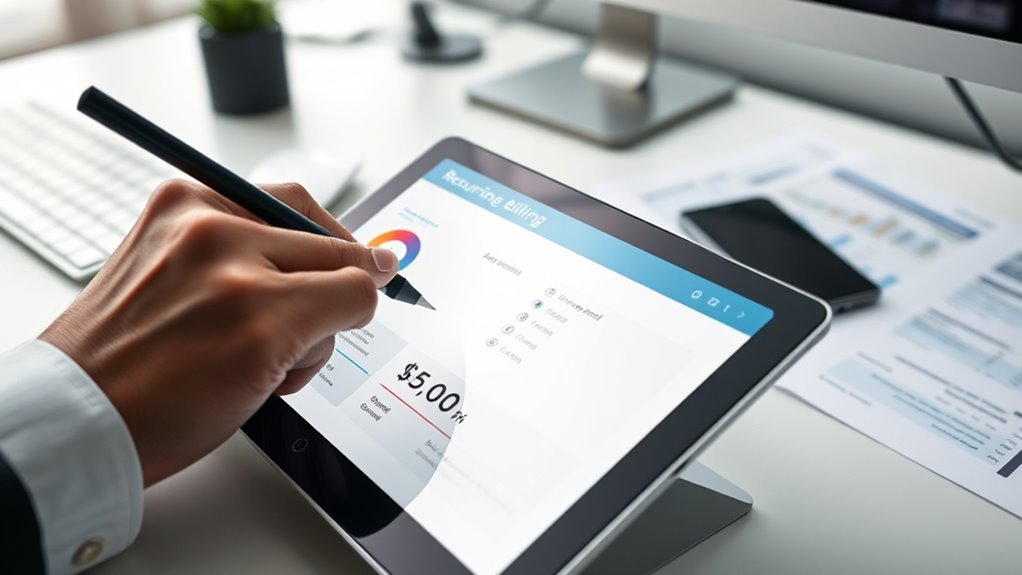To get paid faster, choose a payment processor that supports recurring billing and integrates easily with your systems. Set up clear subscription plans with automatic renewals and secure customer consent. Automate billing schedules, specify accepted payment methods, and monitor invoices regularly. Communicate billing terms clearly and offer self-service options for customers. If you implement these steps carefully, you’ll streamline your cash flow—keep going to discover more tips to optimize your payment process.
Key Takeaways
- Choose a secure, PCI DSS-compliant payment processor that supports recurring billing and integrates with your existing systems.
- Define clear subscription plans with set billing intervals, auto-renewal, and customer reminders to streamline payments.
- Obtain explicit customer consent and securely capture payment details to ensure compliance and reduce payment failures.
- Automate the billing process by scheduling recurring invoices, verifying accuracy, and monitoring payment statuses regularly.
- Implement retry policies for failed payments, provide multiple payment methods, and enable self-service options to accelerate cash flow.

Setting up recurring billing is essential for automating customer payments and ensuring consistent revenue. When you streamline this process, you reduce manual tasks, minimize late payments, and create a reliable cash flow. The first step is selecting a payment processor that supports recurring billing functionalities. Look for options that integrate smoothly with your existing systems, whether it’s merchant accounts, accounting software, or SaaS payment platforms. Ensure the processor complies with security standards like PCI DSS to protect your customers’ payment data and avoid costly breaches. Flexibility is key—choose processors offering virtual terminals, payment gateways, invoicing features, APIs, or built-in integrations so you can customize your setup as needed. Don’t forget to compare transaction fees, payout schedules, and customer support quality to find the best fit for your business.
Once you’ve picked a processor, you need to configure your recurring payment plans. Decide on billing intervals—weekly, monthly, or annual—based on your business model and your customers’ preferences. Create specific service or subscription plans within your payment system that clearly specify pricing and payment terms. Set up auto-renewal policies to keep subscriptions active without manual intervention, and incorporate failed payment retries—often called dunning management—to recover missed payments. Customer reminders before billing helps reduce cancellations and disputes. Make sure your billing frequency is explicit in the system so invoices generate on a consistent schedule, and specify accepted payment methods such as credit cards or ACH transfers. If you offer trial periods or discounts, include those details within the plan setup.
Configure billing intervals, create clear plans, enable auto-renewal, and specify payment methods for seamless recurring payments.
Customer payment authorization is critical. You must obtain explicit consent from customers through online agreements or consent forms before starting recurring billing. Securely capture their payment information—credit cards, debit cards, or ACH details—using compliant methods that safeguard sensitive data. Clearly communicate the subscription terms, billing dates, cancellation policies, and renewal conditions to your customers, ensuring transparency and building trust. Providing a self-service portal allows customers to update their payment information or cancel subscriptions easily, which improves customer satisfaction and reduces disputes. Understanding payment security standards is also vital to ensure that customer data remains protected throughout the process. Additionally, understanding the Personality Test can help tailor your communication approach to better meet customer expectations and improve engagement.
Finally, set up your billing process within the software. Access the billing or payments section, create a recurring bill, and input customer details while selecting the recurring option. Set the initial billing date and configure the repeat interval, verifying that it aligns with your customer’s expectations. Regularly review recurring bills for accuracy before they process, and monitor invoice statuses to ensure timely payments. Set expiration dates or termination conditions to prevent unintended charges. Payments should be collected automatically on due dates, with failed transactions retried per your policies. Finally, ensure your system integrates seamlessly with your accounting and management tools, keeping your records aligned and accurate. Automating this process saves time, accelerates cash flow, and makes your billing more predictable.
Frequently Asked Questions
Can I Customize Billing Intervals for Different Customers?
Yes, you can customize billing intervals for different customers. Your software platform, like Dynamics 365, allows you to create unique billing schedule groups with specific frequencies and intervals. You can override default parameters on a per-customer basis, set precise billing cycle dates with Stripe, and even combine multiple intervals in one subscription. This flexibility helps you match billing to each customer’s preferences, improving satisfaction and operational efficiency.
What Payment Methods Are Compatible With Recurring Billing?
Ever wonder which payment methods support your recurring billing? You can accept major credit cards like Visa, MasterCard, American Express, and Discover, making payments seamless for most customers. Digital wallets such as PayPal, Apple Pay, and Google Pay also work well, offering added convenience. ACH bank transfers are popular for U.S. users, providing low-cost, reliable options. Internationally, multi-currency support broadens your reach, ensuring smooth recurring payments worldwide.
How Do I Handle Failed or Declined Payments?
When payments fail or are declined, you should first identify the cause using detailed reason codes. Segment customers based on failure reasons and send personalized recovery messages. Implement smart retry logic to optimize timing, and automate reminders and escalation steps. Proactively update payment info with customers before expiry or limits. Also, keep your payment systems current, validate data accurately, and monitor for technical issues to prevent future declines and improve success rates.
Is There a Way to Pause or Cancel Recurring Subscriptions Easily?
Did you know that customers often find it surprisingly easy to pause or cancel their subscriptions? You can make this process seamless by providing a clear, one-click “click-to-cancel” button on your website or app. Offering a simple pause option can also reduce churn. Just guarantee your cancellation steps are straightforward, transparent, and accessible—no hidden hoops or complicated procedures—to keep your customers satisfied and compliant with regulations.
How Secure Is the Billing Information Stored?
You’re wondering how secure the billing information is stored. Rest assured, it’s protected through encryption and tokenization, which replace sensitive data with secure tokens. Access controls, role-based permissions, and multi-factor authentication limit who can view or handle the data. Regular security audits, vulnerability scans, and physical security measures keep your information safe. These practices guarantee your billing data remains confidential and protected from breaches or unauthorized access.
Conclusion
Now that you know how to set up recurring billing, you’re ready to streamline your payments and improve cash flow. Imagine your business running smoothly, with less chasing after invoices and more focus on growth. Isn’t it time you made billing effortless for both you and your customers? By implementing these steps, you’ll create a seamless experience that keeps your revenue steady and your customers happy. The future of hassle-free billing is just a setup away.









